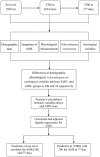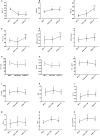Acute Mountain Sickness Is Associated With a High Ratio of Endogenous Testosterone to Estradiol After High-Altitude Exposure at 3,700 m in Young Chinese Men
- PMID: 30740062
- PMCID: PMC6355701
- DOI: 10.3389/fphys.2018.01949
Acute Mountain Sickness Is Associated With a High Ratio of Endogenous Testosterone to Estradiol After High-Altitude Exposure at 3,700 m in Young Chinese Men
Abstract
Background: A large proportion of populations suffer from acute mountain sickness (AMS) after exposure at high altitude. AMS is closely related with age and gender implying that the sex hormones may play critical roles in AMS. Our observational study aimed to identify the association between the endogenous testosterone (T), estradiol (E2) and AMS. Methods: A total of 113 subjects were recruited in 2012. The participants were evaluated at 500 m and after acute (1 day) and short-term (7 days) high-altitude exposure at 3,700 m. The subjects also completed a case report form questionnaire and underwent blood pressure measurements and an echocardiography examination. The red blood cell (RBC) count, Hb concentration ([Hb]), hematocrit (HCT), E2, T, and erythropoietin (EPO) were measured. Results: Upon acute high-altitude exposure, E2 and EPO were significantly lower in AMS+ group, and T/E2 and stroke volume were higher. On the 1st day, AMS score correlated positively with the T/E2 ratio while it negatively correlated with E2. After 7 days at 3,700 m, the AMS+ subjects had higher erythropoietic parameters: EPO, T, and T/E2 were significantly higher in the AMS+ group. [Hb], RBC count, HCT, EPO, T and T/E2 were also correlated with AMS score. EPO, HCT, and the RBC count were also correlated with T/E2. Regression analyses indicated that T/E2 significantly correlated to AMS score and T/E2 on the 1st day was an independent predictor for AMS on the 7th day. Conclusion: AMS was correlated with T/E2 ratio and EPO. After short-term exposure, higher T/E2 may contribute to AMS together with EPO via erythropoiesis. Furthermore, T/E2 level at high altitude in the early stage was an independent predictor for AMS in the latter stage.
Keywords: acute mountain sickness; erythropoiesis; estradiol; high-altitude exposure; testosterone.
Figures



Similar articles
-
Correlation between hematological indicators in acclimatized high-altitude individuals and acute mountain sickness.PeerJ. 2024 Dec 16;12:e18738. doi: 10.7717/peerj.18738. eCollection 2024. PeerJ. 2024. PMID: 39703914 Free PMC article.
-
Relationship between excessive erythrocytosis and acute mountain sickness: a field study.Mil Med Res. 2014 Aug 21;1:18. doi: 10.1186/2054-9369-1-18. eCollection 2014. Mil Med Res. 2014. PMID: 25722874 Free PMC article.
-
Oxidative stress and erythropoietin response in altitude exposure.Clin Invest Med. 2008 Dec 1;31(6):E380-5. doi: 10.25011/cim.v31i6.4925. Clin Invest Med. 2008. PMID: 19032909
-
Plasma soluble erythropoietin receptor is decreased during sleep in Andean highlanders with Chronic Mountain Sickness.J Appl Physiol (1985). 2016 Jul 1;121(1):53-8. doi: 10.1152/japplphysiol.00107.2016. Epub 2016 Apr 28. J Appl Physiol (1985). 2016. PMID: 27125843 Free PMC article.
-
Cardiovascular Indicators of Systemic Circulation and Acute Mountain Sickness: An Observational Cohort Study.Front Physiol. 2021 Aug 27;12:708862. doi: 10.3389/fphys.2021.708862. eCollection 2021. Front Physiol. 2021. PMID: 34512383 Free PMC article.
Cited by
-
AZU1 (HBP/CAP37) and PRKCG (PKC-gamma) may be candidate genes affecting the severity of acute mountain sickness.BMC Med Genomics. 2023 Feb 20;16(1):28. doi: 10.1186/s12920-023-01457-3. BMC Med Genomics. 2023. PMID: 36803152 Free PMC article.
-
Sex-based differences in the prevalence of acute mountain sickness: a meta-analysis.Mil Med Res. 2019 Dec 9;6(1):38. doi: 10.1186/s40779-019-0228-3. Mil Med Res. 2019. PMID: 31813379 Free PMC article. Review.
-
Association between physiological responses after exercise at low altitude and acute mountain sickness upon ascent is sex-dependent.Mil Med Res. 2020 Nov 5;7(1):53. doi: 10.1186/s40779-020-00283-3. Mil Med Res. 2020. PMID: 33148321 Free PMC article.
-
Mechanism, prevention and treatment of cognitive impairment caused by high altitude exposure.Front Physiol. 2023 Sep 4;14:1191058. doi: 10.3389/fphys.2023.1191058. eCollection 2023. Front Physiol. 2023. PMID: 37731540 Free PMC article. Review.
-
Hypoxia and low temperature upregulate transferrin to induce hypercoagulability at high altitude.Blood. 2022 Nov 10;140(19):2063-2075. doi: 10.1182/blood.2022016410. Blood. 2022. PMID: 36040436 Free PMC article.
References
-
- Bachman E., Travison T. G., Basaria S., Davda M. N., Guo W., Li M., et al. (2013). Testosterone induces erythrocytosis via increased erythropoietin and suppressed hepcidin: evidence for a new erythropoietin/hemoglobin set point. J. Gerontol. A Biol. Sci. Med. Sci. 69 725–735. 10.1093/gerona/glt154 - DOI - PMC - PubMed
LinkOut - more resources
Full Text Sources
Research Materials

